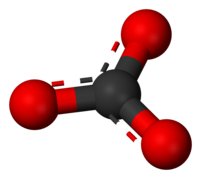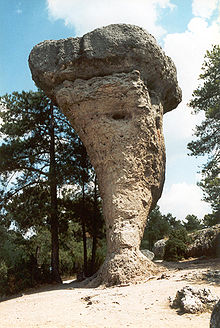Carbonate
The carbonates are the salts of carbonic acid or esters with the group R-O-C(=O)-O-R'. The salts have in common the anion CO32- and are derived from carbonic acid H2CO3. Depending on the pH (the acidity of the solution) they are in chemical equilibrium with bicarbonate and carbon dioxide.
Most carbonates, apart from the alkali metal carbonates, are sparingly soluble in water. Due to this characteristic they are important in geochemistry and are part of many minerals and rocks.
The most abundant carbonate is calcium carbonate (CaCO3), which is found in different mineral forms (calcite, aragonite), forming sedimentary rocks (limestone, marl) or metamorphic (marble) and it is often the natural cement of some sandstones.
Replacing part of the calcium with magnesium, the dolomite CaMg(CO3)2 is obtained, named after the French geologist Déodat Gratet de Dolomieu.
Many carbonates are unstable at high temperatures and lose carbon dioxide as they transform into oxides.
Description
Carbonates in nature are formed from carbonic acid in aqueous solution derived from the dissolution of carbon dioxide in water and in which a small fraction forms carbonic acid according to the reaction:
CO2 + H2O ↔ H2CO3
This reaction is very slow and therefore part of the CO2 dissolved in water is not in the form of carbonic acid. Carbonic acid is in equilibrium with the bicarbonate anion and the carbonate anion according to the following equations:
H2CO3 + H2O ↔ HCO3- + H3O+ (K1 = 2 10−4)
and
HCO3- + H2O ↔ CO32- (K2 = 4.8 10−11)
For many years it was thought that in the carbonate ion only two oxygens carried the negative charge. Crystallographic studies of calcite by W.L. Bragg X-rays revealed that all three C-O bonds were identical. This observation required a new structure and it was not until the development of resonance theory that in 1931 a new structure was proposed in which each oxygen shared 2/3 of the the negative charge and in which the bonds were partial, that is, halfway between simple and double:
In this way, the carbonate ion has a planar geometry with a C-O bond length of 1.29 Å, between the single bond (1.34 Å) and the double bond (1.20 Å). Each C–O bond is made up of a single σ bond and a 2/3 fraction of a π bond. The carbonate ion is one of the simplest of the oxocarbon ions.
Applications
Carbonates are applied in many fields. Minerals such as calcite and dolomite are important in the manufacture of cement and construction stone. Often their use is linked to the specific compound, such as obtaining quicklime (CaO) from calcium carbonate. Other carbonate minerals constitute metal ores: barium whiterite; strontium strontianite; iron siderite; manganese rhodochrosite; zinc smithsonite, and lead cerussite.
One of the most industrially important carbonates is sodium carbonate. In nature it is found in some saline lagoons, for example in Egypt, although the vast majority is obtained from lime in the Solvay process. It is an intermediate in obtaining products as diverse as soap, sodium percarbonate used as a bleach, glass, soda (NaOH), etc.
Wood ash is also largely made up of carbonates. These have even given the name to an element, potassium (K) from the English "pot ash = ash under the boiler" since it was usually obtained from this source.
Due to their character as salts of a weak acid, carbonates are also used as cheap bases. In this application, carbon dioxide is released and the salt formed by the metal that was attached to the carbonate and the rest of the neutralized acid remain in solution:
- MCO3 + 2HX → H2O + CO2 + MX2
Where M is a metal, such as calcium or magnesium, and X is the anion of an acid. In this way, calcium carbonate in water would release carbon dioxide and calcium hydroxide, giving rise to basic solutions according to the following chemical balances:
(1) CaCO3 + H2O → HCO3- + Ca(OH)+
(2) HCO3- + H2O+ Ca(OH)+ → H2CO3 + Ca(OH)2 and carbonic acid in water decomposes releasing carbon dioxide according to:
(3) H2CO3 → H2O + CO2
This reaction is used in the detection of carbonates due to its characteristic effervescence in which water and carbon dioxide are released. There are various methods of quantifying the carbonates present in a sample, by quantifying CO 2 detached. Some include the passage of the CO2 released by an aqueous solution of barium hydroxide, and the quantification of the precipitated barium carbonate, while others such as "Bernard" calcimetry consist of in the volumetric detection of carbon dioxide.
Calcium carbonate is part of the formulation of toothpastes.
Minerals
There are about 80 carbonate minerals, most of which are rare. Even so, while nitrates and borates are scarce minerals in nature, the simpler carbonates are quite abundant. They are part of the chemical composition of numerous rocks, being the essential component of limestone, dolomites and crystalline marbles. They are also ores of numerous metals. The most important minerals of the carbonate group are calcite, aragonite (CaCO3), and dolomite (MgCa(CO3)2). Other important ones are smithsonite (ZnCO3), rhodochrosite (MnCO3) and magnesite (MgCO3). These are grouped into sub-groups called the calcite group (trigonal system), the aragonite group (orthorhombic system) and the dolomite (trigonal) groups and monoclinic carbonates such as malachite (Cu2CO3(OH)2) and azurite (Cu3(CO3) 2(OH)2), with the presence of hydroxide ions in its structure.
Carbonates usually appear in the form of minerals such as calcite in which calcium can be replaced by Mn2+, Fe2+ or Mg ions >2+, in isomorphic series that extend from (I) siderite (FeCO3) to magnesite (MgCO3) passing through ankerite (FeCa(CO3)2) and dolomite (MgCa(CO3)2); (II) from magnesite and siderite to rhodochrosite (MnCO3) and (III) from dolomite and ankerite to kutnahorite.,
Carbonates tend to have a medium hardness with typical values of 3 - 5 on the Mohs scale.
Carbonated salts
In the following periodic table, the carbonated salts are arranged according to the corresponding elements, indicating their molecular weight (g/mol). In addition to the carbonates indicated in the following periodic table, there are also others such as ammonium carbonate (NH4)2CO3 and ammonium bicarbonate (NH4)HCO3.
| 63, 03 H2CO3 | He | ||||||||||||||||
| 73.89 Li2CO3 | 69.02 BeCO3 | B | C | N | O | F | Ne | ||||||||||
| 105.99 Na2CO3 | 84.31 MgCO3 | 233,99 Al2(CO3)3 | Yeah. | P | S | Cl | Ar | ||||||||||
| 138.20 K2CO3 | 100.87 CaCO3 | Sc | Ti | V | Cr | 114.95 MnCO3 | 115.84 FeCO3 | 118.94 CoCO3 | 118.70 NiCO3 | 123.55 CuCO3 | 125.38 ZnCO3 | Ga | Ge | As | Separate | Br | Kr |
| 230,94 Rb2CO3 | 147.63 SrCO3 | And | Zr | Nb | Mo | Tc | Ru | Rh | Pd | 275,74 Ag2CO3 | 176.41 CdCO3 | In | Sn | Sb | You | I | Xe |
| 325.82 Cs2CO3 | 197,34 BaCO3 | Hf | Ta | W | Re | You | Go | Pt | Au | Hg | 468,77 Tl2CO3 | 267,21 PbCO3 | Bi | Po | At | Rn | |
Fr | Ra | Rf | Db | Sg | Bh | Hs | Mt | Ds | Rg | Cn | Nh | Fl | Mc | Lv | Ts | Og |
| Lantana | 457,84 La2(CO3)3 | Ce | Pr | Nd | Pm | Sm | Eu | Gd | Tb | Dy | Ho | Er | Tm | Yb | Lu | ||
| Arrested | 89 Ac | 90 Th | 91 Pa | 92 U | 93 Np | 94 Pu | 95 Am | 96 Cm | 97 Bk | 98 Cf | 99 That's it. | 100 Fm | 101 Md | 102. No. | 103 Lr |
| Alcalinos | Alcalinotérre | Lantana | Arrested | Transition metals |
| P block metals | Metaloids | No metals | Halogens | Noble and Transactinid gases |
Chemistry
As discussed above, carbonates react with acids releasing water and carbon dioxide. In the case of calcium carbonate:
- CaCO3 + 2HCl → CaCl2 + H2O + CO2
Carbon salts are formed in aqueous media in which there are dissolved metal cations and in which a stream of carbon dioxide is infused. This process is schematized by the following reactions:
1) CO2 (g) + H2O → H2CO3 (acu.)
2) H2CO3↔ H+ + HCO3-
3) HCO3- ↔ H+ + CO32-
In turn, metal cations with positive charges, M+, M2+ or M3+ will react with the carbonate anion to give the following rooms:
4) 2M+ + CO32- → M2CO3
5) M2+ + CO32- → OLC3
6) 2M3+ + 3CO32- → M2(CO3 )3
Reaction (5) is the case of the formation of calcareous or karst deposits in the form of stalactites, stalagmites or incrustations in areas rich in limestone and carbonate rocks:
- Ca2+(acu.) + CO32- → CaCO3 (s)
Thermal stability
Carbonates decompose thermally, releasing carbon dioxide and giving rise to the corresponding metal oxide according to the following reaction:
M2CO3 → M2O + CO2 (alkali cations: Li +, Na+, K+, Rb+, Cs+)
MCO3 → MO + CO2 (alkaline earth cations: Be2+, Mg2+, Ca2+, Sr2+, Ba2+, Ra2+)
The thermal stability of carbonates grows with the size of the cations that compose them. In this way, for a given period the stability grows with the group (alkaline earth > alkaline) and for a given group it increases as we descend: MgCO3 (400°C), CaCO3 (900°C), SrCO3 (1290°C), BaCO3 (1360 °C). The calcite decomposition process is called calcination, derived from the process of obtaining quicklime from calcium carbonate:
- CaCO3 → CaO + CO2 (g)
Organic carbonates
Organic carbonates are esters of carbonic acid. They can be formed from phosgene (Cl2C=O) and the corresponding alcohol.
Especially polycarbonates based on dialcohols such as 2,2-bis(4-hydroxyphenyl)-propane (HOC6H4-C(CH3 )2-C6H4OH)) have gained importance as highly transparent materials in the manufacture of CDs or as a substitute for of the glass.
Contenido relacionado
Gas chromatography
Molecularity
Glass




